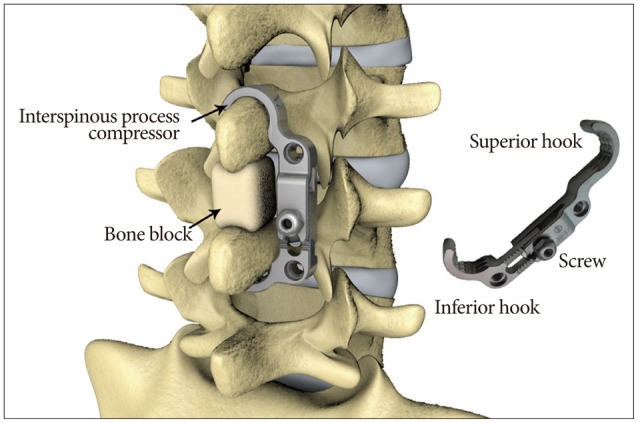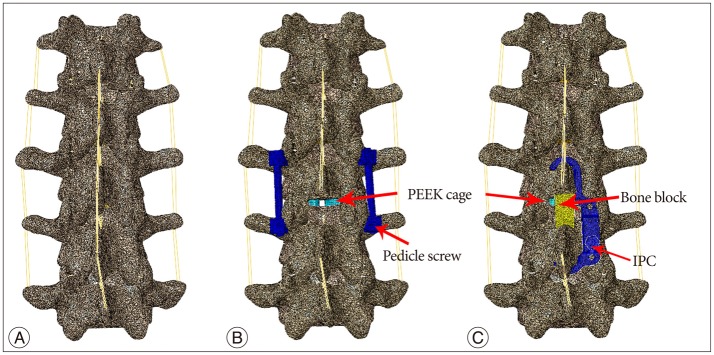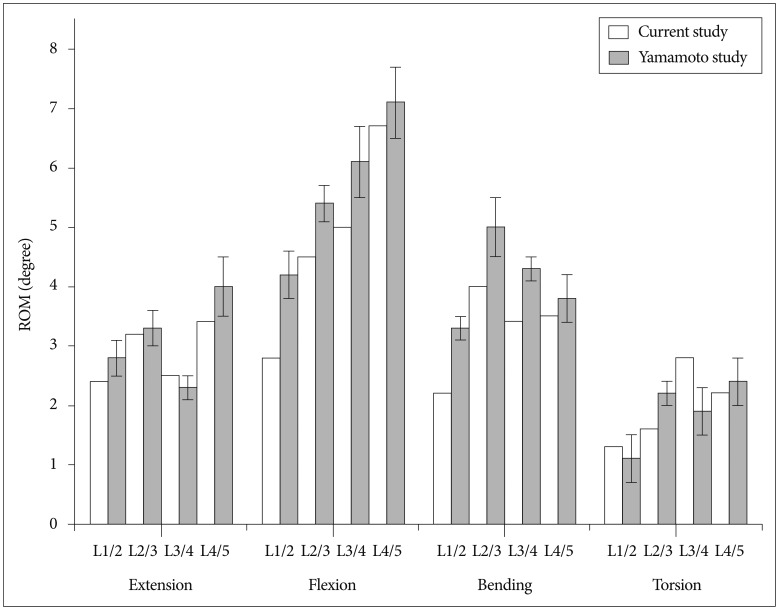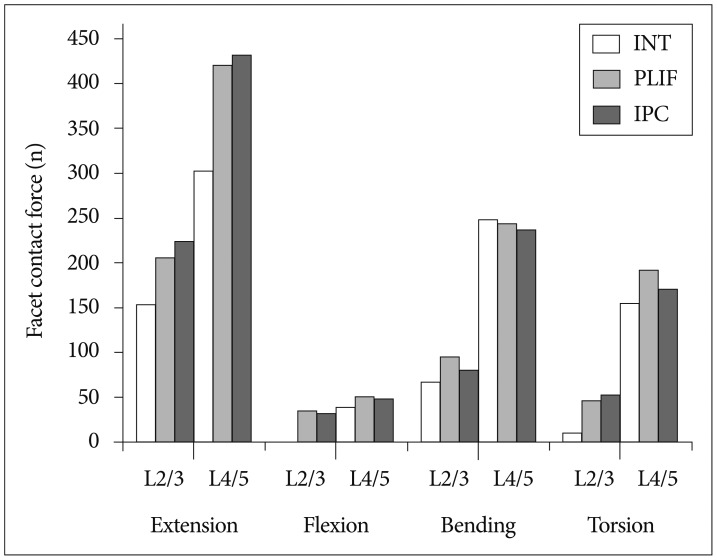J Korean Neurosurg Soc.
2016 Mar;59(2):91-97. 10.3340/jkns.2016.59.2.91.
Biomechanical Comparison of Spinal Fusion Methods Using Interspinous Process Compressor and Pedicle Screw Fixation System Based on Finite Element Method
- Affiliations
-
- 1Department of Medical System Engineering, Gwangju Institute of Science and Technology (GIST), Gwangju, Korea.
- 2School of Mechatronics, Gwangju Institute of Science and Technology (GIST), Gwangju, Korea.
- 3Department of Neurosurgery, Yonsei University College of Medicine, Seoul, Korea. CISTERN@yuhs.ac
- KMID: 2192037
- DOI: http://doi.org/10.3340/jkns.2016.59.2.91
Abstract
OBJECTIVE
To investigate the biomechanical effects of a newly proposed Interspinous Process Compressor (IPC) and compare with pedicle screw fixation at surgical and adjacent levels of lumbar spine.
METHODS
A three dimensional finite element model of intact lumbar spine was constructed and two spinal fusion models using pedicle screw fixation system and a new type of interspinous devices, IPC, were developed. The biomechanical effects such as range of motion (ROM) and facet contact force were analyzed at surgical level (L3/4) and adjacent levels (L2/3, L4/5). In addition, the stress in adjacent intervertebral discs (D2, D4) was investigated.
RESULTS
The entire results show biomechanical parameters such as ROM, facet contact force, and stress in adjacent intervertebral discs were similar between PLIF and IPC models in all motions based on the assumption that the implants were perfectly fused with the spine.
CONCLUSION
The newly proposed fusion device, IPC, had similar fusion effect at surgical level, and biomechanical effects at adjacent levels were also similar with those of pedicle screw fixation system. However, for clinical applications, real fusion effect between spinous process and hooks, duration of fusion, and influence on spinous process need to be investigated through clinical study.
Keyword
MeSH Terms
Figure
Reference
-
1. Anasetti F, Galbusera F, Aziz HN, Bellini CM, Addis A, Villa T, et al. Spine stability after implantation of an interspinous device : an in vitro and finite element biomechanical study. J Neurosurg Spine. 2010; 13:568–575. PMID: 21039145.
Article2. Bono CM, Lee CK. Critical analysis of trends in fusion for degenerative disc disease over the past 20 years : influence of technique on fusion rate and clinical outcome. Spine (Phila Pa 1976). 2004; 29:455–463. discussion Z5PMID: 15094543.
Article3. Byun DH, Shin DA, Kim JM, Kim SH, Kim HI. Finite element analysis of the biomechanical effect of coflex™ on the lumbar spine. Korean J Spine. 2012; 9:131–136. PMID: 25983803.
Article4. Carreon LY, Puno RM, Dimar JR 2nd, Glassman SD, Johnson JR. Perioperative complications of posterior lumbar decompression and arthrodesis in older adults. J Bone Joint Surg Am. 2003; 85-A:2089–2092. PMID: 14630835.
Article5. Chen SH, Zhong ZC, Chen CS, Chen WJ, Hung C. Biomechanical comparison between lumbar disc arthroplasty and fusion. Med Eng Phys. 2009; 31:244–253. PMID: 18760654.
Article6. Chosa E, Goto K, Totoribe K, Tajima N. Analysis of the effect of lumbar spine fusion on the superior adjacent intervertebral disk in the presence of disk degeneration, using the three-dimensional finite element method. J Spinal Disord Tech. 2004; 17:134–139. PMID: 15260097.
Article7. Erbulut DU, Zafarparandeh I, Hassan CR, Lazoglu I, Ozer AF. Determination of the biomechanical effect of an interspinous process device on implanted and adjacent lumbar spinal segments using a hybrid testing protocol : a finite-element study. J Neurosurg Spine. 2015; 23:200–208. PMID: 25932601.
Article8. Fischgrund JS, Mackay M, Herkowitz HN, Brower R, Montgomery DM, Kurz LT. 1997 Volvo Award winner in clinical studies. Degenerative lumbar spondylolisthesis with spinal stenosis : a prospective, randomized study comparing decompressive laminectomy and arthrodesis with and without spinal instrumentation. Spine (Phila Pa 1976). 1997; 22:2807–2812. PMID: 9431616.9. Gaines RW Jr. The use of pedicle-screw internal fixation for the operative treatment of spinal disorders. J Bone Joint Surg Am. 2000; 82-A:1458–1476. PMID: 11057475.
Article10. Goel VK, Monroe BT, Gilbertson LG, Brinckmann P. Interlaminar shear stresses and laminae separation in a disc. Finite element analysis of the L3-L4 motion segment subjected to axial compressive loads. Spine (Phila Pa 1976). 1995; 20:689–698. PMID: 7604345.11. Jutte PC, Castelein RM. Complications of pedicle screws in lumbar and lumbosacral fusions in 105 consecutive primary operations. Eur Spine J. 2002; 11:594–598. PMID: 12522719.
Article12. Kang KT, Kim HJ, Son J, Yeom JS, Chun HJ. Comparing an instrumented posterior fixation system with rigid and semi-flexible rods using finite element analysis. Int J Precis Eng Manuf. 2015; 16:163–170.
Article13. Kim HJ, Bak KH, Chun HJ, Oh SJ, Kang TH, Yang MS. Posterior interspinous fusion device for one-level fusion in degenerative lumbar spine disease : comparison with pedicle screw fixation - preliminary report of at least one year follow up. J Korean Neurosurg Soc. 2012; 52:359–364. PMID: 23133725.
Article14. Kim HJ, Chun HJ, Moon SH, Kang KT, Kim HS, Park JO, et al. Analysis of biomechanical changes after removal of instrumentation in lumbar arthrodesis by finite element analysis. Med Biol Eng Comput. 2010; 48:703–709. PMID: 20440570.
Article15. Kim TY, Kang KT, Yoon DH, Shin HC, Kim KN, Yi S, et al. Effects of lumbar arthrodesis on adjacent segments : differences between surgical techniques. Spine (Phila Pa 1976). 2012; 37:1456–1462. PMID: 22333957.16. Lavaste F, Skalli W, Robin S, Roy-Camille R, Mazel C. Three-dimensional geometrical and mechanical modelling of the lumbar spine. J Biomech. 1992; 25:1153–1164. PMID: 1400515.
Article17. Lo CC, Tsai KJ, Chen SH, Zhong ZC, Hung C. Biomechanical effect after Coflex and Coflex rivet implantation for segmental instability at surgical and adjacent segments : a finite element analysis. Comput Methods Biomech Biomed Engin. 2011; 14:969–978. PMID: 21607887.
Article18. Park SC, Yoon SH, Hong YP, Kim KJ, Chung SK, Kim HJ. Minimum 2-year follow-up result of degenerative spinal stenosis treated with interspinous u (coflex). J Korean Neurosurg Soc. 2009; 46:292–299. PMID: 19893715.
Article19. Polikeit A, Nolte LP, Ferguson SJ. The effect of cement augmentation on the load transfer in an osteoporotic functional spinal unit : finite-element analysis. Spine (Phila Pa 1976). 2003; 28:991–996. PMID: 12768136.
Article20. Rohlmann A, Bauer L, Zander T, Bergmann G, Wilke HJ. Determination of trunk muscle forces for flexion and extension by using a validated finite element model of the lumbar spine and measured in vivo data. J Biomech. 2006; 39:981–989. PMID: 16549091.
Article21. Rohlmann A, Neller S, Claes L, Bergmann G, Wilke HJ. Influence of a follower load on intradiscal pressure and intersegmental rotation of the lumbar spine. Spine (Phila Pa 1976). 2001; 26:E557–E561. PMID: 11740371.
Article22. Rohlmann A, Zander T, Bergmann G. Spinal loads after osteoporotic vertebral fractures treated by vertebroplasty or kyphoplasty. Eur Spine J. 2006; 15:1255–1264. PMID: 16311752.
Article23. Serhan H, Mhatre D, Defossez H, Bono CM. Motion-preserving technologies for degenerative lumbar spine : the past, present, and future horizons. SAS J. 2011; 5:75–89. PMID: 25802672.
Article24. Shirazi-Adl SA, Shrivastava SC, Ahmed AM. Stress analysis of the lumbar disc-body unit in compression. A three-dimensional nonlinear finite element study. Spine (Phila Pa 1976). 1984; 9:120–134. PMID: 6233710.
Article25. Thomsen K, Christensen FB, Eiskjaer SP, Hansen ES, Fruensgaard S, Bünger CE. 1997 Volvo Award winner in clinical studies. The effect of pedicle screw instrumentation on functional outcome and fusion rates in posterolateral lumbar spinal fusion : a prospective, randomized clinical study. Spine (Phila Pa 1976). 1997; 22:2813–2822. PMID: 9431617.26. Vadapalli S, Sairyo K, Goel VK, Robon M, Biyani A, Khandha A, et al. Biomechanical rationale for using polyetheretherketone (PEEK) spacers for lumbar interbody fusion-a finite element study. Spine (Phila Pa 1976). 2006; 31:E992–E998. PMID: 17172990.
Article27. Xiao Z, Wang L, Gong H, Zhu D. Biomechanical evaluation of three surgical scenarios of posterior lumbar interbody fusion by finite element analysis. Biomed Eng Online. 2012; 11:31. PMID: 22709659.
Article
- Full Text Links
- Actions
-
Cited
- CITED
-
- Close
- Share
- Similar articles
-
- Biomechanical Analysis of Fusion Segment Rigidity Upon Stress at Both the Fusion and Adjacent Segments: A Comparison between Unilateral and Bilateral Pedicle Screw Fixation
- Comparative Finite Element Analysis of Lumbar Cortical Screws and Pedicle Screws in Transforaminal and Posterior Lumbar Interbody Fusion
- Biomechanical Study on Three Screw-Based Atlantoaxial Fixation Techniques: A Finite Element Study
- A Biomechanical Comparison of 2 Different Topping-off Devices and Their Influence on the Sacroiliac Joint Following Lumbosacral Fusion Surgery
- Unilateral versus Bilateral Pedide Scrwe Fixation in Lumbar Spinal Fusion







